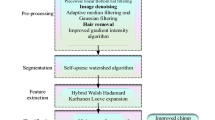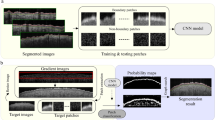Abstract
In recent years, image processing technics have attracted much attention as powerful tools in the assessment of skin lesions from multispectral images. The Kubelka–Munk Genetic Algorithm (KMGA) is a novel method which has been developed for this diagnostic purpose. It combines the Kubelka–Munk light–tissue interaction model with the Genetic Algorithm optimization process, and allows quantitative measure of cutaneous tissue by computing skin parameter maps such as melanin concentration, volume blood fraction, oxygen saturation or epidermis/dermis thickness. However, its efficiency is seriously reduced by the mass floating-point operations for each pixel of the multispectral image, and this prevents the algorithm from reaching industrial standards related to cost, power and speed for clinical applications. In this paper, our work focuses on the improvement of this theoretical achievement. Therefore, we repropose a new C-based Parallel and Optimized KMGA (PO-KMGA) technique designed and optimized using multiple ways: KM model optimized re-writing, operation massively parallelized using POSIX threads, memory use optimization and routine pipelining with Intel C++ Compiler, etc. Intensive experiments demonstrate that our introduced PO-KMGA framework spends less than 10 min to finish a job that the conventional KMGA spends around two days to do in the same hardware environment with a similar algorithm performance.









Similar content being viewed by others
References
Iso/iec 9945–1. ansi/ieee std 1003.1. information technology—portable operating system interface (posix): part 1: system application interface (api) [c language] (1996)
Optimization of high speed pipelining in FPGA-based FIR filter design using genetic algorithm, vol. 8401 (2012). doi:10.1117/12.918934
W.H.O.: How common is skin cancer? Online (2014)
Kim, A.D., Moscoso, M.: Light transport in two-layer tissues. J. Biomed. Opt. 10(3), 034015 (2005). doi:10.1117/1.1925227
Akgun, D.: A practical parallel implementation for tdlms image filter on multi-core processor. J. Real Time Image Process. pp. 1–12 (2014). doi:10.1007/s11554-014-0397-y
Andin, J.M., Arenaz, M., Rodrguez, G., Tourio, J.: A novel compiler support for automatic parallelization on multicore systems. Parallel Comput. 39(9), 442–460 (2013)
Armstrong, B., Kim, S.W., Park, I., Voss, M., Eigenmann, R.: Compiler-based tools for analyzing parallel programs. Parallel Comput. 24, 401–420 (1998)
Ayguade, E., Copty, N., Duran, A., Hoeflinger, J., Lin, Y., Massaioli, F., Teruel, X., Unnikrishnan, P., Zhang, G.: The design of openmp tasks. Parallel Distrib. Syst. IEEE Trans. 20(3), 404–418 (2009)
Barney, B.: Introduction to parallel computing. https://computing.llnl.gov/tutorials/parallel comp/
Barney, B.: Posix threads programming. https://computing.llnl.gov/tutorials/pthreads/
Bartovsk, J., Dokldal, P., Dokldalov, E., Georgiev, V.: Parallel implementation of sequential morphological filters. J. Real Time Image Proc. 9(2), 315–327 (2014)
Biswal, P., Mondal, P., Banerjee, S.: Parallel architecture for accelerating affine transform in high-speed imaging systems. J. Real Time Image Proc. 8(1), 69–79 (2013)
Gaetano, R., Chierchia, G., Pesquet-Popescu, B.: Parallel implementations of a disparity estimation algorithm based on a proximal splitting method. In: VCIP, pp. 1–6. IEEE (2012)
Garcia, C., Botella, G., Ayuso, F., Prieto, M., Tirado, F.: Multi-gpu based on multicriteria optimization for motion estimation system. EURASIP J. Adv. Signal Process. 2013(1), 23 (2013). doi:10.1186/1687-6180-2013-23
Hosseini, F., Fijany, A., Safari, S., Fontaine, J.G.: Fast implementation of dense stereo vision algorithms on a highly parallel simd architecture. J. Real Time Image Proc. 8(4), 421–435 (2013)
Jacques, S.L.: Spectroscopic determination of tissue optical properties using optical fiber spectrometer. Tech. rep. (2008). http://omlc.ogi.edu/news/apr08/skinspectra/index.html
Jolivot, R.: Development of an imaging system dedicated to the acquisition, analysis and multispectral characterisation of skin lesions. Ph.D. thesis, University of Burgundy (2011). http://tel.archives-ouvertes.fr/tel-00695305
Jolivot, R., Benezeth, Y., Marzani, F.: Skin parameter map retrieval from a dedicated multispectral imaging system applied to dermatology/cosmetology. Int. J. Biomed. Imaging 2013, 15 (2013)
Kubelka, P., Munk, F.: Ein beitrag zur optik der farbanstriche. Zeitschrift fr tech. Physik 9, 593601 (1931)
Kyrkou, C., Theocharides, T.: A parallel hardware architecture for real-time object detection with support vector machines. Comput. IEEE Trans. 61(6), 831–842 (2012)
Li, X., Cai, J.: Robust transmission of jpeg2000 encoded images over packet loss channels. In: Multimedia and Expo, 2007 IEEE International Conference on, pp. 947–950 (2007)
Lucas, R., McMichael, T., Smith, W., Armstrong, B.: Solar ultraviolet radiation: global burden of disease from solar ultraviolet radiation. Tech. rep., Environmental Burden of Disease Series—WHO, No. 13 (2006)
Prigent, S., Descombes, X., Zugaj, D., Martel, P., Zerubia, J.: Multi-spectral image analysis for skin pigmentation classification pp. 3641–3644 (2010). doi:10.1109/ICIP.2010.5652072
Prigent, S., Descombes, X., Zugaj, D., Zerubia, J.: Spectral analysis and unsupervised svm classification for skin hyper-pigmentation classification pp. 1–4 (2010). doi:10.1109/WHISPERS.2010.5594917
Schmitt, J.M., Zhou, G.X., Walker, E.C., Wall, R.T.: Multilayer model of photon diffusion in skin. J. Opt. Soc. Am. A 7(11), 2141–2153 (1990)
Choi, S.H.: Fast and robust extraction of optical and morphological properties of human skin using a hybrid stochastic-deterministic algorithm: Monte-carlo simulation study. Lasers Med Sci. pp. 733–741 (2010)
Shimada, M., Yamada, Y., Itoh, M., Yatagai, T.: Melanin and blood concentration in human skin studied by multiple regression analysis: experiments. Phys Med Biol 46(9), 2385 (2001)
Stratton, J.A., Stone, S.S., Wen-Mei, W.H.: Mcuda: An efficient implementation of cuda kernels for multi-core cpus. In: Languages and Compilers for Parallel Computing, pp. 16–30. Springer, Berlin (2008)
Svaasand, L., Norvang, L., Fiskerstrand, E., Stopps, E., Berns, M., Nelson, J.: Tissue parameters determining the visual appearance of normal skin and port-wine stains. Lasers Med. Sci. 10(1), 55–65 (1995)
Syswerda, G.: Uniform crossover in genetic algorithms. In: Proceedings of the 3rd International Conference on Genetic Algorithms, pp. 2–9. Morgan Kaufmann Publishers Inc., San Francisco, CA, USA (1989). http://dl.acm.org/citation.cfm?id=645512.657265
Takatani, S., Graham, M.D.: Theoretical analysis of diffuse reflectance from a two-layer tissue model. Biomed. Eng. IEEE Trans. BME, 26(12), 656–664 (1979)
Thomos, N., Boulgouris, N., Strintzis, M.: Optimized transmission of jpeg2000 streams over wireless channels. Image Process IEEE Trans 15(1), 54–67 (2006)
van Tol, M., Jesshope, C., Lankamp, M., Polstra, S.: An implementation of the SANE virtual processor using POSIX threads. J. Syst. Architect. 55(3), 162–169 (2009)
Tsumura, N., Ojima, N., Sato, K., Shiraishi, M., Shimizu, H., Nabeshima, H., Akazaki, S., Hori, K., Miyake, Y.: Image-based skin color and texture analysis/synthesis by extracting hemoglobin and melanin information in the skin. ACM Trans. Graph. 22(3), 770–779 (2003). doi:10.1145/882262.882344
Viator, J.A., Jung, B., Svaasand, L.O., Aguilar, G., Nelson, J.S., Zhang, R., Verkruysse, W., Choi, B.: Determination of human skin optical properties from spectrophotometric measurements based on optimization by genetic algorithms. J. Biomed. Opt. 10(2), 024,030–024,030–11 (2005)
Xu, T., Wang, Y., Zhang, Z.: Pixel-wise skin colour detection based on flexible neural tree. Image Process. IET 7(8), 751–761 (2013). doi:10.1049/iet-ipr.2012.0657
Zonios, G., Bykowski, J., Kollias, N.: Skin melanin, hemoglobin, and light scattering properties can be quantitatively assessed in vivo using diffuse reflectance spectroscopy. J. Invest. Dermatol. 117(6), 1452–1457 (2001). doi:10.1046/j.0022-202x.2001.01577.x
Acknowledgments
The authors would like to thank the China Scholarship Council, the Conseil Régional de Bourgogne-France and the Fond Européen de Développement Régional-France for their funding to our studies.
Author information
Authors and Affiliations
Corresponding author
Rights and permissions
About this article
Cite this article
Li, C., Brost, V., Benezeth, Y. et al. Design and evaluation of a parallel and optimized light–tissue interaction-based method for fast skin lesion assessment. J Real-Time Image Proc 15, 407–420 (2018). https://doi.org/10.1007/s11554-015-0494-6
Received:
Accepted:
Published:
Issue Date:
DOI: https://doi.org/10.1007/s11554-015-0494-6




